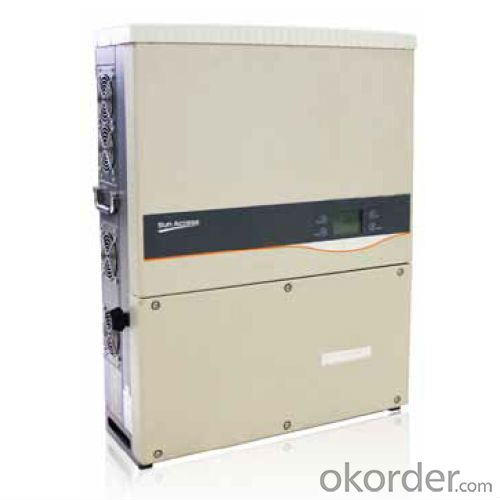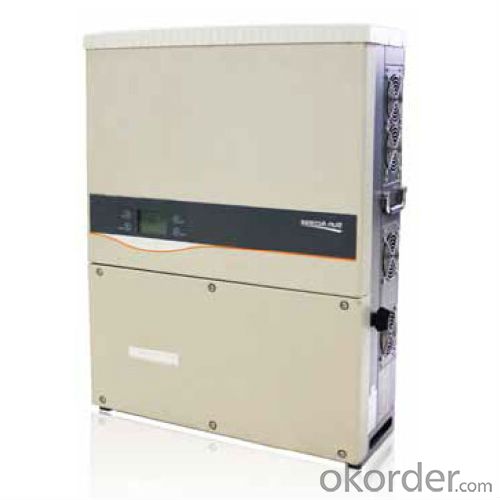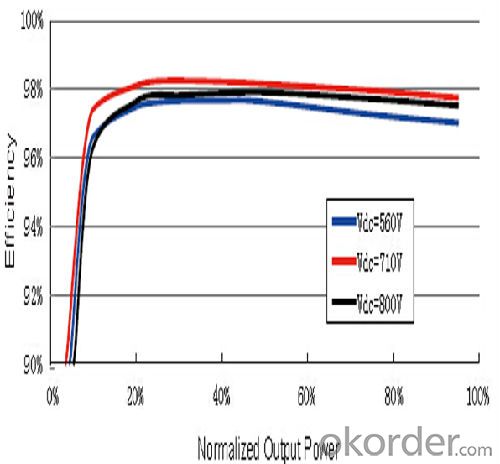Loading Port:China Main Port
Payment Terms:TT or LC
Min Order Qty:50 unit
Supply Capability:10000 unit/month
1. Structure of Photovoltaic Grid-Connected Inverter SG40KTL Description
A solar inverter, or PV inverter, or Solar converter, converts the variable direct current (DC) output of a photovoltaic (PV) solar panel into
autility frequency alternating current (AC) that can be fed into a commercial electrical grid or used by a local, off-grid electrical network.
It is acritical BOS–component in a photovoltaic system, allowing the use of ordinary AC-powered equipment.
Solar inverters have special functions adapted for use with photovoltaic arrays, including maximum power point tracking and anti-islanding protection.
Suitable for 50Hz/60Hz grid, could be used in Asia, Africa and Europe. Available for hand installation, no need for lifting machinery
assistance.
2. Main Features of the Photovoltaic Grid-Connected Inverter SG40KTL
• Full 36kW effective power at power factor of 0.9 due to apparent power reserves up to 39.8kVA
• Max. Efficiency at 98.3%
• Dual MPP trackers control
• Reduced cabling on AC side due to higher output voltage of 480Vac
• Integrated combiner box: 8 x MC4 connector pairs with DC string fuses, Type II overvoltage protection and DC switch, more safety and lower the system cost
• Can be wall-mounted without lifting equipment, weight 65 kg
• Active power continuously adjustable (0~100%)
• Reactive power control with power factor 0.8 overexcited ~ 0.8 underexcited
• Includes RS-485 interface, compatible with all common monitoring systems
• Product certification: TÜV, BDEW and CGC
• Manufacturer certification: ISO 9001, ISO 14001, OHSAS 18000
3. Photovoltaic Grid-Connected Inverter SG40KTL Images



4. Photovoltaic Grid-Connected Inverter SG40KTL Specification
Input Side Data | |
Max. PV input power | 40500W |
Max. PV input voltage | 1000V |
Startup voltage | 300V |
Nominal input voltage | 710V |
MPP voltage range | 280~950V |
MPP voltage range for nominal power | 560~800V |
No. of MPPTs | 2 |
Max. number of PV strings per MPPT | 4 |
Max. PV input current | 66A(33A/33A) |
Max. current for input connector | 12A |
Output Side Data | |
Nominal AC output power | 36000W |
Max AC output power(PF=1) | 39800W |
Max. AC output apparent power | 39800VA |
Max. AC output current | 48A |
Nominal AC voltage | 3/N/PE, 277/480Vac or 3/PE, 480Vac |
AC voltage range | 422~528Vac |
Nominal grid frequency | 50Hz/60Hz |
Grid frequency range | 45~55Hz/55~ 65Hz |
THD | < 3 % (Nominal power) |
DC current injection | <0.5 %In |
Power factor | >0.99@default value at nominal power |
(adj. 0.8overexcited ~0.8underexited) | |
Protection | |
Anti-islanding protection | Yes |
LVRT | Yes |
DC reverse connection protection | Yes |
AC short circuit protection | Yes |
Leakage current protection | Yes |
DC switch | Yes |
DC fuse | Yes |
Overvoltage protection | DC Type II DIN rail surge arrester(40KA) |
System Data | |
Max. efficiency | 98.30% |
Max. European efficiency | 98.00% |
Isolation method | Transformerless |
Ingress protection rating | IP65 |
Night power consumption | <1W |
Operating ambient temperature range | -25~60℃(>45℃ derating) |
Allowable relative humidity range | 0~100% |
Cooling method | Smart forced air cooling |
Max. operating altitude | 4000m (>3000m derating) |
Display | Graphic LCD |
Communication | RS485(RJ45 connector) |
DC connection type | MC4 |
AC connection type | Screw Clamp terminal |
Certification | VDE0126-1-1, EN62109-1, EN62109-2,BDEW, |
CGC, NRS 097-2-1, GB/T 19964, UTE C15-712-1 | |
IEC 61683, IEC 60068-2, IEC61727, IEC62116, | |
IEC62109-1, IEC62109-2, EN50178, IEC62103, | |
EN61000-6-1, EN61000-6-2, EN61000-6-3, EN61000-6-4 | |
Mechanical Data | |
Dimensions(W×H×D) | 634×820×257mm |
Mounting method | Wall bracket |
Weight | 65kg |
5. FAQ of Photovoltaic Grid-Connected Inverter SG40KTL
Q1. What is the difference between inverter and solar inverter?
A1. Inverter only has AC inpput, but solar inverter both connect to AC input and solar panel, it saves more power.
Q2. What is the difference between MPPT&PWM?
A2. MPPT has higher efficiency, it can track the max power point and won't waste energy.